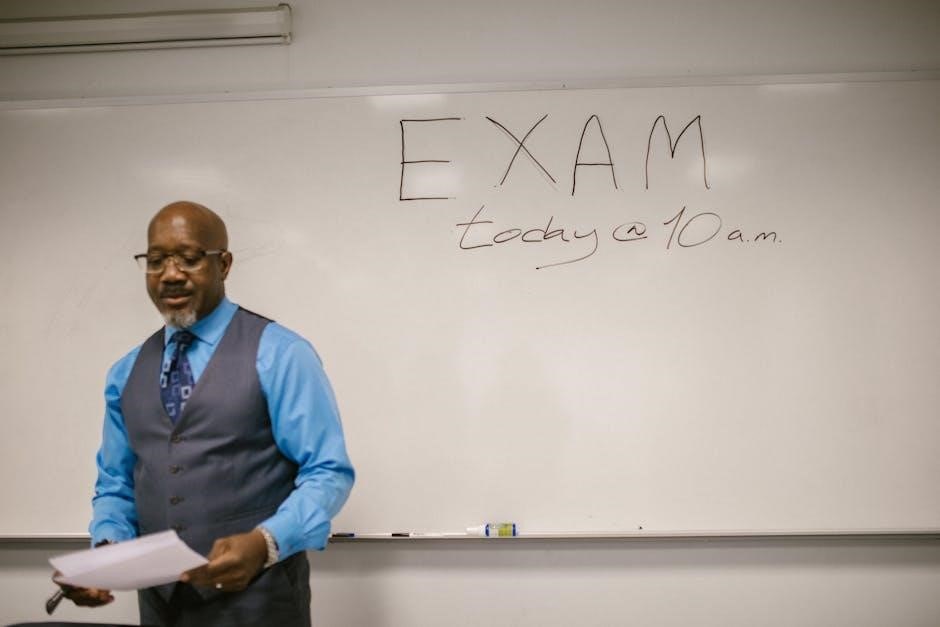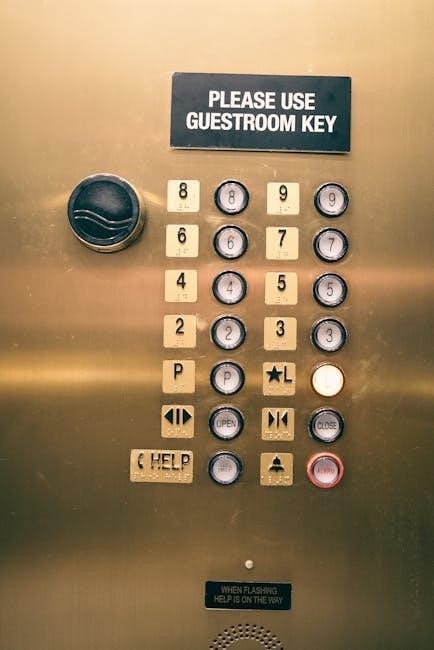tekonsha voyager operating instructions

This section provides a comprehensive guide on effectively using your Tekonsha Voyager brake controller. It includes detailed instructions on adjusting power levels, understanding the manual braking feature, and troubleshooting common issues. Proper operation ensures safe and controlled towing experiences for various vehicles.
Overview of Tekonsha Voyager Brake Controller
The Tekonsha Voyager brake controller is a proportional electric brake controller designed to provide smooth and secure trailer braking. It’s an entry-level device perfect for those new to towing or seeking a reliable, cost-effective solution. The Voyager utilizes a patented braking sensor to detect the tow vehicle’s deceleration rate, applying proportional braking force to the trailer’s electric brakes. This synchronization between the tow vehicle and trailer ensures controlled and consistent stopping power.
Its compact size and user-friendly interface make the Tekonsha Voyager easy to install and operate; The controller features an LED indicator to visually display braking activity and a manual override lever for immediate trailer brake application. The Voyager is designed for broad vehicle compatibility and is suitable for use with trailers equipped with 1 to 4 axles. This proportional brake controller offers exceptional value for enhanced towing safety. The Voyager offers a blend of reliability, ease of use, and proportional braking. It’s a great choice for various towing applications;
Key Features and Versatility
The Tekonsha Voyager stands out with its key features that contribute to its versatility and user-friendly design. Its compact size minimizes interference with the tow vehicle’s electrical system, ensuring seamless integration. The four-wire hookup simplifies installation, while the broad setting range allows customization for various trailer weights and braking preferences. The Voyager’s compatibility with most vehicles further enhances its versatility, making it a suitable choice for diverse towing setups.
The Voyager’s proportional braking system delivers smooth and responsive braking performance, enhancing safety and control. The manual override lever provides immediate trailer brake activation, while the LED indicator offers visual confirmation of braking activity. These features provide the driver with added confidence and peace of mind. The Tekonsha Voyager is designed to meet N.H.T.S.A. regulations regarding tow vehicle/trailer light activation. It makes it a reliable and compliant option for towing needs. The included mounting bracket, screws, owner’s manual, and wiring ensure a hassle-free installation.
Vehicle Compatibility (Ford, GM, Dodge, Toyota, Jeep etc.)
The Tekonsha Voyager brake controller exhibits broad vehicle compatibility, making it a versatile choice for numerous towing applications. It is designed to work seamlessly with a wide array of vehicles, including popular brands like Ford, GM, Chevrolet, Dodge, RAM, Toyota, and Jeep. Its compatibility extends to vehicles with 2, 4, 6, and 8 brakes, accommodating trailers with 1 to 4 axles.
For enhanced installation convenience, vehicle-specific Tekonsha Plug & Play harnesses are often available. These harnesses allow direct connection to the factory tow package harness, simplifying the wiring process. By utilizing a Plug & Play harness, users can avoid complex wiring modifications and ensure a secure, reliable connection. To determine compatibility with a specific vehicle, it is recommended to consult the vehicle’s manual or contact Tekonsha’s technical support. This will ensure proper installation and optimal performance of the brake controller. The Voyager’s compatibility and adaptability make it a popular choice for various towing needs.
Wiring Diagram and Connections
The Tekonsha Voyager brake controller utilizes a four-wire connection system, simplifying the wiring process. Understanding the wiring diagram is crucial for proper installation. The white wire serves as the ground connection and should be securely attached to the negative post on the vehicle’s battery. The black wire provides power to the controller and connects to the positive battery post. The red wire taps into the vehicle’s stoplight switch, activating the trailer brakes when the brake pedal is pressed. Finally, the blue wire carries the braking signal to the trailer’s electric brakes.
For many vehicles, a direct-fit wiring harness can be used to simplify the connection process, especially if the vehicle is equipped with a factory tow package. These harnesses eliminate the need for splicing and provide a secure, reliable connection. If a direct-fit harness is not available, the universal four-wire harness included with the brake controller can be used. It is essential to follow the wiring diagram carefully and ensure all connections are secure to prevent malfunctions.
Connecting to the Stoplight Switch
Connecting the Tekonsha Voyager’s red wire to the vehicle’s stoplight switch is a critical step in the installation process, enabling the brake controller to activate the trailer brakes in sync with the tow vehicle’s braking. This connection ensures that when the driver presses the brake pedal, both the vehicle and trailer brakes are applied simultaneously, providing smooth and controlled stopping power.
To make this connection, it’s essential to identify the correct wire on the stoplight switch circuit. Consult the vehicle’s service manual or wiring diagram to pinpoint the wire that carries a 12-volt signal only when the brake pedal is depressed. Once identified, use a wire connector or similar method to securely tap into this wire. Ensure the connection is robust and insulated to prevent shorts or loose connections, which can lead to brake controller malfunction.
Proper connection to the stoplight switch is vital for the brake controller to function correctly and provide safe and reliable trailer braking.
Grounding the White Wire
Grounding the white wire of the Tekonsha Voyager brake controller is a fundamental step to ensure the proper and safe operation of the device. The white wire serves as the ground connection, providing a return path for the electrical current to complete the circuit. A secure and reliable ground connection is essential for the brake controller to function correctly and prevent potential electrical issues.
The recommended grounding point is the negative post of the vehicle’s battery. This provides a direct and clean connection to the vehicle’s electrical system ground, minimizing the risk of interference or voltage drops. To establish this connection, securely attach the white wire to the negative battery post using a ring terminal and ensure the connection is tight and free from corrosion.
Alternatively, if connecting to the battery post is not feasible, you can ground the white wire to a clean, bare metal surface on the vehicle’s frame. Ensure the chosen location is free from paint, rust, or other contaminants that could impede the electrical connection. Use a self-tapping screw or bolt to securely attach the wire to the frame.
Connecting the Black Wire to Positive Battery Post
Connecting the black wire of the Tekonsha Voyager brake controller to the positive battery post is a crucial step in providing the necessary power for its operation. The black wire serves as the primary power source for the brake controller, drawing energy directly from the vehicle’s battery to activate the trailer brakes. A secure and reliable connection is essential for the brake controller to function correctly and ensure consistent braking performance.
Before connecting the black wire, disconnect the negative terminal of the vehicle’s battery to prevent any accidental short circuits or electrical damage. Then, attach the black wire to the positive battery post using a ring terminal and ensure the connection is tight and secure. A loose or corroded connection can lead to voltage drops and intermittent braking issues.
After the black wire is securely connected, reattach the negative terminal of the vehicle’s battery. Always double-check all connections to ensure they are properly installed and tightened before testing the brake controller.

Running the Blue Wire to the Trailer Connector
The blue wire of the Tekonsha Voyager brake controller plays a vital role in transmitting the braking signal to the trailer’s electric brakes. This wire carries the electrical current that activates the trailer brakes in proportion to the tow vehicle’s braking force. Therefore, properly running and connecting the blue wire to the trailer connector is crucial for safe and effective braking.
Start by running the blue wire from the brake controller, typically located under the dashboard, to the rear of the tow vehicle where the trailer connector is located. Secure the wire along the vehicle’s frame, using zip ties or other fasteners to prevent it from dragging or getting damaged. Avoid running the wire near hot exhaust components or sharp edges that could compromise its insulation.
Once the blue wire reaches the trailer connector, connect it to the corresponding pin that controls the electric brakes. Ensure the connection is secure and properly insulated to prevent corrosion or short circuits. A reliable connection ensures the trailer brakes activate seamlessly with the tow vehicle’s brakes.
Installation and Mounting Guidelines (-20 to 70 degrees)
Proper installation and mounting of the Tekonsha Voyager brake controller are essential for optimal performance and safety. The Voyager must be securely mounted within a specific angular range, between -20 degrees (nose down) and 70 degrees (nose up), relative to the direction of travel. This ensures the internal pendulum functions correctly, providing accurate proportional braking.
Select a mounting location inside the tow vehicle that is easily accessible to the driver and allows for a clear view of the LED display. The mounting surface should be solid and free from obstructions. Use the provided mounting bracket and screws to securely attach the Voyager. Avoid mounting the controller in areas where it may be exposed to extreme temperatures, moisture, or direct sunlight.
It is crucial to periodically inspect the mounting to ensure the controller remains securely fastened. A loose or improperly mounted controller can lead to erratic braking performance and compromise safety. Adhering to these guidelines ensures the Voyager operates reliably across various environmental conditions.
Power Adjustment Instructions
Adjusting the power setting on your Tekonsha Voyager is crucial for matching trailer braking force to your towing needs. Before making adjustments, ensure the trailer is connected and the safety chains and electrical connector are securely attached. It’s also advised to warm the trailer brakes by driving a short distance (approximately 1/4 mile) at 45 mph, engaging the manual lever to apply light braking.
Begin by setting the power knob to the 12 o’clock position. Drive on a dry, level paved surface at approximately 25 mph. Use the manual slide knob to activate the trailer brakes. If the trailer brakes lock up, reduce the power by rotating the knob counter-clockwise; Conversely, if braking feels insufficient, increase the power by rotating the knob clockwise. Fine-tune the setting until you achieve strong, controlled braking just before wheel lockup.
After adjusting with the manual slide, make a few low-speed stops using the brake pedal to verify the overall braking performance. The goal is smooth, proportional braking that complements the tow vehicle’s brakes. Repeat the adjustment process as needed to optimize braking for different load conditions.
Manual Braking Operation
The Tekonsha Voyager offers a manual braking feature, providing direct control over the trailer brakes independent of the tow vehicle’s brake pedal. This is especially useful in situations requiring immediate or controlled trailer braking, such as downhill descents or emergency stops. To activate manual braking, locate the manual control lever on the unit.
Gently slide the lever to the left. This action sends power directly to the trailer brakes, applying braking force according to the power level previously set. The farther you slide the lever, the more power is delivered to the trailer brakes, up to the maximum setting. It’s crucial to use the manual braking feature judiciously.
Avoid abrupt or excessive application, as this can lead to trailer wheel lockup and loss of control. Instead, use smooth, controlled movements of the lever to modulate the braking force. Downhill, use light, intermittent manual braking to maintain a safe speed.
Familiarize yourself with the feel and response of the manual braking system on a safe, open road before encountering challenging towing conditions. This will enhance your confidence and ability to manage your trailer effectively.
Troubleshooting and Technical Assistance (1-888-785-5832)
Encountering issues with your Tekonsha Voyager brake controller can be frustrating, but many problems can be resolved with simple troubleshooting steps. Begin by checking all wiring connections to ensure they are secure and properly grounded. Inspect the trailer brake wiring for any signs of damage or corrosion. Verify that the brake controller is securely mounted and within the specified angular range of -20 to 70 degrees.
If problems persist, consult the Tekonsha troubleshooting guide for common issues and their solutions. This guide often addresses problems like weak braking, trailer brake lockup, or no brake response; If you cannot resolve the issue independently, Tekonsha provides excellent technical assistance.
For expert help, contact Tekonsha’s dedicated support line at 1-888-785-5832. Their knowledgeable technicians can provide personalized troubleshooting advice, answer technical questions, and guide you through more complex repairs. Additionally, the Tekonsha website offers a comprehensive resource library, including FAQs, wiring diagrams, and downloadable manuals. This combination of resources ensures you have access to the support needed to maintain your Tekonsha Voyager brake controller.

Maintenance and Inspection (Every 3000 miles)

Regular maintenance and inspection are essential for ensuring the longevity and reliable performance of your Tekonsha Voyager brake controller. A recommended interval for these checks is every 3000 miles, or more frequently if you use your trailer extensively or under severe conditions. Start by visually inspecting the brake controller unit for any signs of physical damage, such as cracks, loose connections, or corrosion.
Check the wiring harness and connections, ensuring they are secure and free from wear. Verify that the mounting bracket is firmly attached and that the controller remains within its specified mounting angle. Test the manual override lever to confirm it operates smoothly and provides consistent braking force. It’s important to adjust the trailer brakes every 3000 miles, or as use and performance requires.
Periodically examine the LED indicator to ensure it functions correctly, displaying appropriate braking status. Clean the controller’s exterior with a dry cloth to remove dust and debris. By adhering to this maintenance schedule, you can prevent potential issues, ensure optimal braking performance, and extend the life of your Tekonsha Voyager brake controller.
